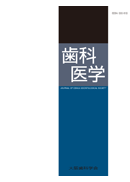Volume 69, Issue 3_4
Displaying 1-33 of 33 articles from this issue
- |<
- <
- 1
- >
- >|
-
Article type: Article
2006 Volume 69 Issue 3_4 Pages 121-128
Published: December 25, 2006
Released on J-STAGE: May 22, 2017
Download PDF (1449K) -
Article type: Article
2006 Volume 69 Issue 3_4 Pages 129-138
Published: December 25, 2006
Released on J-STAGE: May 22, 2017
Download PDF (3414K) -
Article type: Article
2006 Volume 69 Issue 3_4 Pages 139-150
Published: December 25, 2006
Released on J-STAGE: May 22, 2017
Download PDF (4232K) -
Article type: Article
2006 Volume 69 Issue 3_4 Pages 151-159
Published: December 25, 2006
Released on J-STAGE: May 22, 2017
Download PDF (761K) -
Article type: Article
2006 Volume 69 Issue 3_4 Pages 160-165
Published: December 25, 2006
Released on J-STAGE: May 22, 2017
Download PDF (1971K) -
Article type: Article
2006 Volume 69 Issue 3_4 Pages 166-172
Published: December 25, 2006
Released on J-STAGE: May 22, 2017
Download PDF (633K)
-
Article type: Article
2006 Volume 69 Issue 3_4 Pages 173-
Published: December 25, 2006
Released on J-STAGE: May 22, 2017
Download PDF (162K) -
Article type: Article
2006 Volume 69 Issue 3_4 Pages 174-
Published: December 25, 2006
Released on J-STAGE: May 22, 2017
Download PDF (185K) -
Article type: Article
2006 Volume 69 Issue 3_4 Pages 175-
Published: December 25, 2006
Released on J-STAGE: May 22, 2017
Download PDF (175K) -
Article type: Article
2006 Volume 69 Issue 3_4 Pages 175-176
Published: December 25, 2006
Released on J-STAGE: May 22, 2017
Download PDF (297K) -
Article type: Article
2006 Volume 69 Issue 3_4 Pages 176-177
Published: December 25, 2006
Released on J-STAGE: May 22, 2017
Download PDF (254K) -
Article type: Article
2006 Volume 69 Issue 3_4 Pages 178-179
Published: December 25, 2006
Released on J-STAGE: May 22, 2017
Download PDF (302K) -
Article type: Article
2006 Volume 69 Issue 3_4 Pages 179-180
Published: December 25, 2006
Released on J-STAGE: May 22, 2017
Download PDF (288K) -
Article type: Article
2006 Volume 69 Issue 3_4 Pages 180-181
Published: December 25, 2006
Released on J-STAGE: May 22, 2017
Download PDF (264K) -
Article type: Article
2006 Volume 69 Issue 3_4 Pages 181-182
Published: December 25, 2006
Released on J-STAGE: May 22, 2017
Download PDF (276K) -
Article type: Article
2006 Volume 69 Issue 3_4 Pages 182-183
Published: December 25, 2006
Released on J-STAGE: May 22, 2017
Download PDF (294K) -
Article type: Article
2006 Volume 69 Issue 3_4 Pages 183-184
Published: December 25, 2006
Released on J-STAGE: May 22, 2017
Download PDF (296K) -
Article type: Article
2006 Volume 69 Issue 3_4 Pages 184-185
Published: December 25, 2006
Released on J-STAGE: May 22, 2017
Download PDF (300K) -
Article type: Article
2006 Volume 69 Issue 3_4 Pages 185-186
Published: December 25, 2006
Released on J-STAGE: May 22, 2017
Download PDF (316K) -
Article type: Article
2006 Volume 69 Issue 3_4 Pages 186-187
Published: December 25, 2006
Released on J-STAGE: May 22, 2017
Download PDF (305K) -
Influence of platelet-rich plasma on epithelial cells from the viewpoint of periodontal regenerationArticle type: Article
2006 Volume 69 Issue 3_4 Pages 187-188
Published: December 25, 2006
Released on J-STAGE: May 22, 2017
Download PDF (294K) -
Article type: Article
2006 Volume 69 Issue 3_4 Pages 188-189
Published: December 25, 2006
Released on J-STAGE: May 22, 2017
Download PDF (263K) -
Article type: Article
2006 Volume 69 Issue 3_4 Pages 189-
Published: December 25, 2006
Released on J-STAGE: May 22, 2017
Download PDF (132K)
-
Article type: Article
2006 Volume 69 Issue 3_4 Pages 190-
Published: December 25, 2006
Released on J-STAGE: May 22, 2017
Download PDF (183K) -
Article type: Article
2006 Volume 69 Issue 3_4 Pages 190-191
Published: December 25, 2006
Released on J-STAGE: May 22, 2017
Download PDF (330K) -
Article type: Article
2006 Volume 69 Issue 3_4 Pages 191-
Published: December 25, 2006
Released on J-STAGE: May 22, 2017
Download PDF (201K)
-
Article type: Article
2006 Volume 69 Issue 3_4 Pages A1-A2
Published: December 25, 2006
Released on J-STAGE: May 22, 2017
Download PDF (259K) -
Article type: Article
2006 Volume 69 Issue 3_4 Pages A2-A3
Published: December 25, 2006
Released on J-STAGE: May 22, 2017
Download PDF (221K) -
Article type: Article
2006 Volume 69 Issue 3_4 Pages A4-A5
Published: December 25, 2006
Released on J-STAGE: May 22, 2017
Download PDF (239K) -
Article type: Article
2006 Volume 69 Issue 3_4 Pages A5-A6
Published: December 25, 2006
Released on J-STAGE: May 22, 2017
Download PDF (265K) -
Article type: Article
2006 Volume 69 Issue 3_4 Pages A7-A8
Published: December 25, 2006
Released on J-STAGE: May 22, 2017
Download PDF (253K) -
Article type: Article
2006 Volume 69 Issue 3_4 Pages A8-A9
Published: December 25, 2006
Released on J-STAGE: May 22, 2017
Download PDF (202K) -
Article type: Article
2006 Volume 69 Issue 3_4 Pages A11-A12
Published: December 25, 2006
Released on J-STAGE: May 22, 2017
Download PDF (237K)
- |<
- <
- 1
- >
- >|
